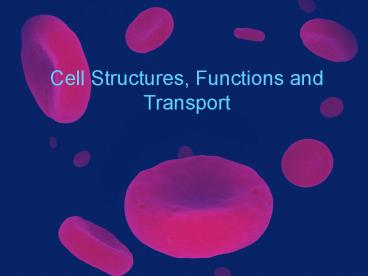Cell Structures, Functions and Transport PowerPoint PPT Presentation
1 / 46
Title: Cell Structures, Functions and Transport
1
Cell Structures, Functions and Transport
2
Animal Cell
Cytoplasm
Nucleolus
Nucleus
Cell Membrane
3
Eukaryotic Cell Organelles and Function
- Nucleus
- Nickname The Control Center
- Function holds the DNA
- Parts
- Nucleolus dark spot in the middle of the
nucleus that helps make ribosomes
4
Animal Cell
Cytoplasm
Nucleolus
Ribosomes
Nucleus
Cell Membrane
5
Eukaryotic Cell Organelles and Function
- Ribosomes
- Function makes proteins
- Found in all cells, prokaryotic and eukaryotic
6
Eukaryotic Cell Organelles and Function
- Endoplasmic Reticulum (ER)
- Nickname Roads
- Function The internal delivery system of the
cell
7
Animal Cell
Cytoplasm
Nucleolus
Ribosomes
Nucleus
Cell Membrane
Smooth Endoplasmic Reticulum
Rough Endoplasmic Reticulum
8
Endoplasmic Reticulum
- 2 Types
- Rough ER
- Rough appearance because it has ribosomes
- Function helps make proteins, thats why it has
ribosomes - Smooth ER
- NO ribosomes
- Function makes fats or lipids
9
Animal Cell
Cytoplasm
Ribosomes
Nucleolus
Nucleus
Cell Membrane
Smooth Endoplasmic Reticulum
Rough Endoplasmic Reticulum
Golgi Complex
10
Eukaryotic Cell Organelles and Function
- Golgi Complex
- Nickname The shippers
- Function packages, modifies, and transports
materials to different location inside/outside of
the cell - Appearance stack of pancakes
11
Animal Cell
Cytoplasm
Nucleolus
Ribosomes
Nucleus
Cell Membrane
Smooth Endoplasmic Reticulum
Rough Endoplasmic Reticulum
Golgi Bodies
12
Eukaryotic Cell Organelles and Function
- Lysosomes circular, but bigger than ribosomes
- Nickname Clean-up Crews
- Function to break down food into particles the
rest of the cell can use and to destroy old cells
13
Animal Cell
Cytoplasm
Nucleolus
Ribosomes
Nucleus
Cell Membrane
Mitochondria
Smooth Endoplasmic Reticulum
Rough Endoplasmic Reticulum
Golgi Bodies
14
Eukaryotic Cell Organelles and Function
- Mitochondria
- Nickname The Powerhouse
- Function Energy formation
- Breaks down food to make ATP
- ATP is the major fuel for all cell activities
that require energy
15
(No Transcript)
16
Animal Cell
Cytoplasm
Nucleolus
Ribosomes
Nucleus
Cell Membrane
Mitochondria
Smooth Endoplasmic Reticulum
Rough Endoplasmic Reticulum
Golgi Bodies
17
- Now lets talk about structures only found in
PLANT Cells!!
18
Plant Cell
Vacuole
Cell Membrane
19
Eukaryotic Cell Organelles and Function
- Vacuoles
- Function stores water
- This is what makes lettuce crisp
- When there is no water, the plant wilts
20
Plant Cell
Vacuole
Chloroplasts
Cell Membrane
21
Eukaryotic Cell Organelles and Function
- Chloroplasts
- Function traps energy from the sun to produce
food for the plant cell - Green in color because of chlorophyll, which is a
green pigment
22
Chloroplasts
23
Plant Cell
Vacuole
Chloroplasts
Cell Membrane
Cell Wall
24
Eukaryotic Cell Organelles and Function
- Cell Wall
- Function provides support and protection to the
cell membrane - Found outside the cell membrane in plant cells
25
Plant Cell
Cytoplasm
Smooth ER
Vacuole
Ribosomes
Chloroplasts
Cell Membrane
Cell Wall
Nucleolus
Golgi Bodies
Nucleus
Mitochondria
Rough ER
26
(No Transcript)
27
Diffusion Osmosis
28
Define Diffusion
29
Define Diffusion
- The movement of molecules from a area in which
they are highly concentrated to a area in which
they are less concentrated.
30
Draw a diagram of an example of diffusion we saw
in class.
31
Draw a diagram of an example of diffusion we saw
in class.
32
See an animation of diffusion here
- http//lewis.eeb.uconn.edu/lewishome/applets/Diffu
sion/diffusion.html
33
Define osmosis
34
Define osmosis
- The diffusion of water across a selectively
permeable membrane.
35
Define osmosis
- Water moves from a high concentration of water
(less salt or sugar dissolved in it) to a low
concentration of water (more salt or sugar
dissolved in it). This means that water would
cross a selectively permeable membrane from a
dilute solution (less dissolved in it) to a
concentrated solution (more dissolved in it).
http//www.usd.edu/bgoodman/Osmos.htm
36
Define osmosis
http//www.usd.edu/bgoodman/Osmos.htm
37
Define osmosis
- In this picture a red blood cell is put in a
glass of distilled water (all water with no salt
or sugar in it). Because there is a higher
concentration of water outside the cell, water
enters the cell by OSMOSIS. In this case too
much water enters and the cell swells to the
point of bursting open. In the end pieces of
cell membrane are left in the water.
http//www.usd.edu/bgoodman/Osmos.htm
38
See an animation of osmosis here
- http//lewis.eeb.uconn.edu/lewishome/applets/Osmos
is/osmosis.html
39
Define selectively permeable membrane
40
Define selectively permeable membrane
- A membrane that allows only certain materials to
cross it - Materials pass through pores in the membrane
41
For more information on diffusion osmosis,
click here
- http//edtech.clas.pdx.edu/osmosis_tutorial/defaul
t.html
42
Why are osmosis diffusion important?
43
Why are osmosis diffusion important?
- All living things have certain requirements they
must satisfy in order to remain alive maintain
homeostasis - These include exchanging gases (usually CO2 and
O2), taking in water, minerals, and food, and
eliminating wastes. - These tasks happen at the cellular level.
- Molecules move through the cell membrane by
diffusion
44
Why are osmosis diffusion important?
- All living things have certain requirements they
must satisfy in order to remain alive. These
include exchanging gases (usually CO2 and O2),
taking in water, minerals, and food, and
eliminating wastes. These tasks ultimately occur
at the cellular level, and require that molecules
move through the membrane that surrounds the
cell.
45
Why are osmosis diffusion important?
- This membrane is a complex structure that is
responsible for separating the contents of the
cell from its surroundings, for controlling the
movement of materials into and out of the cell,
and for interacting with the environment
surrounding the cell.
46
Review Osmosis Diffusion Here
- http//wappingersschools.org/WJH/teachers/science
/Jim_Site/asignments/cells/diffusionetc/diffusion_
osmosis.html

